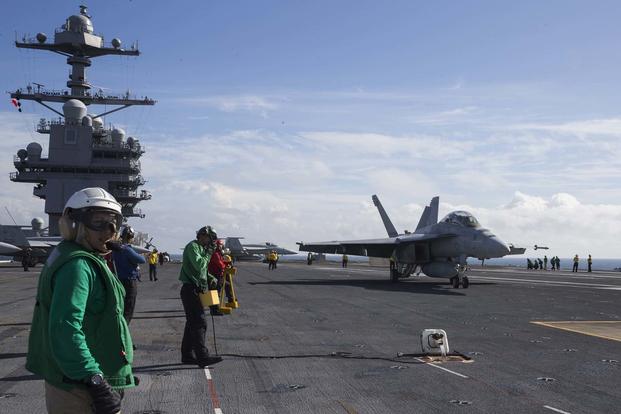The admiral responsible for developing and maintaining the Navy‘s ships defended the new $13 billion aircraft carrier that has faced heat from politicians and government watchdogs after a series of technological problems plagued its development.
Vice Adm. Thomas Moore, head of Naval Sea Systems Command, told reporters Tuesday that the aircraft carrier Gerald R. Ford will prove useful for decades to come.
“I’m well aware of some of the criticism of the ship, but 15-20 years, we’re going to look back and go, ‘We are happy to have that Ford-class carrier around,’ ” Moore said at a breakfast with defense reporters in Washington, D.C.
The Navy is working through a series of problems that have left the Ford — the first in the class of next-generation aircraft carriers and the service’s most expensive ship — behind schedule and over budget.
Members of Congress have pressed Navy leaders on some of the problems that have led to the delays, including those with its advanced weapons elevators and electromagnetic aircraft launch system, or EMALS.
The first of the Ford’s 11 elevators, which are supposed to move more ordnance faster compared to the cable elevators on Nimitz-class carriers, was finally ready for use in January. Navy Secretary Richard Spencer pledged to have the rest up and running by the end of the summer. Otherwise, he told President Donald Trump, “you can fire me.”
And Ford’s EMALS, the first-of-its-kind catapult that replaced the steam systems used on older carriers, has been called too expensive and “no good” by Trump after he visited the ship in 2017.
Moore acknowledged that the Navy “bit off an awful lot” with the Ford. Almost everything about it, other than the shape of the hull itself, is new, he said. It takes time to figure it all out.
He pledged that sailors will “work our way through the technology challenges.”
The Navy initially planned to spread the new systems out across three new carriers, but, in the early 2000s, leaders made the decision to put it all on the first of the Ford-class carriers.
The other approach would not have been as contentious, Moore added, but the Navy will work through the technological problems with the Ford-class carriers a lot faster than it would have otherwise.
“I’m not sure we were glad to go through all the growing pains we’ve had with [Ford],” he said. “But … it’s going to be a great ship, and we’ll be glad we have it for the next 50 years, for sure.”
— Gina Harkins can be reached at gina.harkins@military.com. Follow her on Twitter @ginaaharkins.

